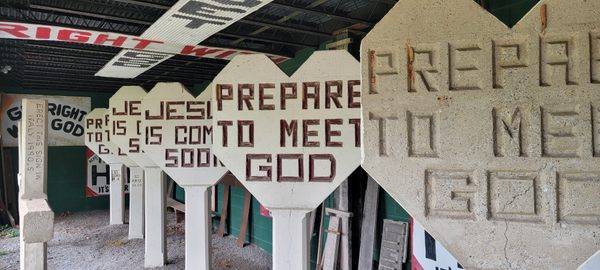Henry Harrison Mayes (1898-1986) was a coal miner in Mingo Hollow, west of Middlesboro, Kentucky, just north of the Kentucky-Tennessee state line. He was also, as he referred to himself, “God’s Advertiser.” It took Burma Shave five signs to try to sell shaving cream but with a single sign, Mayes would declare, “IF YOU GO TO HELL IT’S YOUR FAULT.”
While working as a car coupler deep in a mine at age 18 or 19, Mayes was almost killed when a fully loaded coal car broke free and crushed him against a mine wall, shattering his chest. His family was told he would not survive the night but Mayes—who had wanted to become a preacher but felt his fifth-grade education made him unqualified—prayed, promising god that if he were to live, he would do everything he could to convert people to Christianity. Although Mayes had, as a teenager, tacked transcriptions from the Bible onto telephone poles, it was then that Mayes fully became an evangelist.
Many of Mayes’ earliest evangelical exhortations were made using painted wood, cardboard, and oilcloth. Maps drawn by Mayes show schematically his trips through the United States. By one estimate, he put up over 1,600 wooden and cardboard signs in 25 states by the mid-1940s. Mayes and his wife, Mary Lillie, a midwife generally known as Lillie, strived to repair and replace these early works but given their fragility, vast number, and wide distribution, ongoing maintenance was prohibitively difficult.
Around 1945, Mayes began creating concrete markers, with the material chosen for its permanency. Using self-made wooden molds and hand-mixed concrete, Mayes cast crosses and heart-shaped signs with short messages in all capitals on both sides—often “JESUS IS COMING SOON” and “PREPARE TO MEET GOD.” The hearts are roughly two feet high by two feet wide. Approximately one-third of the nine-foot-tall support, 10 inches wide, would be buried in the ground. The crosses are around the same size and reportedly weighed 1,400 pounds. Mayes often painted the signs or the letters or both to make them more visible. In addition to the evangelical messages, many of the markers have instructions regarding when and where they should be installed; for example, “ERECT THIS SIGN IN EGYPT – 1990-5.”
Mayes cast the markers in the yard behind his and Lillie’s Middlesboro home. During the summer, Mayes hired acquaintances with flatbed trucks to drive him and the concrete markers around the United States. Mayes could place the markers in a freshly dug hole in as little as five minutes, by rolling them off the back of a truck or using block and tackle. (Mayes never learned to drive but he owned bicycles adorned with signs advising people to “GET RIGHT WITH GOD.” His first bike can be seen at the Tennessee State Museum in Nashville.)
Erecting the markers was problematic from the outset and remained so. Mayes exercised some discretion when he selected a location—he often placed them along a fence line so they wouldn’t intrude upon either farmland or the highway right-of-way—but he did not ask for the permission. His son Clyde admits, “He once put a cross on a golf course.” Annoyed property owners, highway widening, vehicular accidents, vandals … whereas there were once numerous concrete roadside signs, very few remain today.
Harrison and Lillie died in 1988. When their Middleboro home was about to be sold eight years later, John Rice Irwin, founder of the Museum of Appalachia, acquired the signs that had been cast but not installed, along with other artifacts. The museum is the single largest repository of Mayes’ markers but approximately 30 signs—mostly in Tennessee, Kentucky, and North Carolina—can be found “in the field.”

